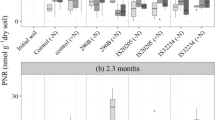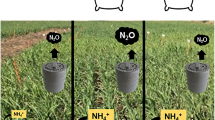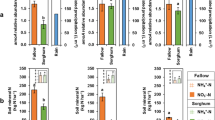Abstract
Sorghum has a great capacity to release biological nitrification inhibitors (BNIs), but the inhibitory effect on nitrification and ammonia oxidizer populations under planted soil conditions is unclear. A pot experiment with three nitrogen (N) application rates (0, 50, and 200 mg N kg−1) was set up to detect the influence of sorghum growth on soil nitrification and investigate the function of blocking the activity of ammonia oxidizers. A 15N-labeled experiment was also conducted to detect the N form absorbed by sorghum. Sorghum root exudates were collected at 30 days after transplanting to hydroponic culture and added into cultured soil to determine the shifts in the populations of nitrifiers. The 15N labeling experiment showed that the uptake rate by sorghum of ammonium N fertilizer was 24% and that of nitrate N fertilizer was 9%, indicating that sorghum was an ammonium using plant. Compared with unplanted soil, sorghum planting had a significant inhibitory effect on the nitrification process even at the high-N fertilizer rates. Autotrophic nitrification was the prevailing process, and sorghum root exudation inhibited this process as much as dicyandiamide (DCD, 10 mg kg−1). Root exudates had a significant inhibitory effect on ammonia-oxidizing bacteria (AOB) but had no effect on ammonia-oxidizing archaea (AOA).




Similar content being viewed by others
References
Berg P, Klemedtsson L, Rosswall T (1982) Inhibitory effect of low partial pressures of acetylene on nitrification. Soil Biol Biochem 14(3):301–303
Castells E, Peñuelas J, Valentine DW (2004) Are phenolic compounds released from the Mediterranean shrub Cistus albidus responsible for changes in N cycling in siliceous and calcareous soils? New Phytol 162:187–195
Coskun D, Britto DT, Shi WM, Kronzucker HJ (2017) Nitrogen transformations in modern agriculture and the role of biological nitrification inhibition. Nat Plants 3:17074. https://doi.org/10.1038/nplants.2017.74
Daims H, Lebedeva EV, Pjevac P, Han P, Herbold C, Albertsen M, Jehmlich N, Palatinszky M, Vierheilig J, Bulaev A, Kirkegaard RH, von Bergen M, Rattei T, Bendinger B, Nielsen PH, Wagner M (2015) Complete nitrification by Nitrospira bacteria. Nature 528:504–509. https://doi.org/10.1038/nature16461
Di HJ, Cameron KC, Shen JP, Winefield CS, O'Callaghan M, Bowatte S, He JZ (2009) Nitrification driven by bacteria and not archaea in nitrogen-rich grassland soils. Nat Geosci 2:621–624
Di HJ, Cameron KC, Shen JP, Winefield CS, O'Callaghan M, Bowatte S, He JZ (2010) Ammonia-oxidizing bacteria and archaea grow under contrasting soil nitrogen conditions. FEMS Microbiol Ecol 72:386–394
Garrido F, Henault C, Gaillard H, Germon JC (2000) Inhibitory capacities of acetylene on nitrification in two agricultural soils. Soil Biol Biochem 32:1799–1802
Gopalakrishnan S, Subbarao GV, Nakahara K, Yoshihashi T, Ito O, Maeda I, Ono H, Yoshida M (2007) Nitrification inhibitors from the root tissues of Brachiaria humidicola, a tropical grass. J Agric Food Chem 55:1385–1388
Gopalakrishnan S, Watanabe T, Pearse SJ, Ito O, Hossain ZAKM, Subbarao GV (2009) Biological nitrification inhibition by Brachiaria humidicola roots varies with soil type and inhibits nitrifying bacteria, but not other major soil microorganisms. Soil Sci Plant Nutr 55:725–733
Jia ZJ, Conrad R (2009) Bacteria rather than Archaea dominate microbial ammonia oxidation in an agricultural soil. Environ Microbiol 11:1658–1671
Killham K (1990) Nitrification in coniferous forest soils. Plant Soil 128:31–44
Kleineidam K, Kosmrlj K, Kublik S, Palmer I, Pfab H, Ruser R, Fiedler S, Schloter M (2011) Influence of the nitrification inhibitor 3,4-dimethylpyrazole phosphate (DMPP) on ammonia-oxidizing bacteria and archaea in rhizosphere and bulk soil. Chemosphere 84:182–186
Kraus TEC, Zasoski RJ, Dahlgren RA, Horwath WR, Perston CM (2004) Carbon and nitrogen dynamics in a forest soil amended with purified tannins from different plant species. Soil Biol Biochem 36:309–321
Leininger S, Urich T, Schloter M, Schwark L, Qi J, Nicol GW, Prosser JI, Schuster SC, Schleper C (2006) Archaea predominate among ammonia-oxidizing prokaryotes in soils. Nature 442:806–809
Li YY, Chapman SJ, Nicol GW, Yao HY (2018) Nitrification and nitrifiers in acidic soils. Soil Biol Biochem 116:290–301
Li YY, Wang J, Pan FX, Chapman SJ, Yao HY (2016) Soil nitrogen availability alters rhizodeposition carbon flux into the soil microbial community. J Soils Sediments 16:1472–1480
Minet EP, Ledgard SF, Lanigan GJ, Murphy JB, Grant J, Hennessy D, Lewis E, Forrestal P, Richards KG (2016) Mixing dicyandiamide (DCD) with supplementary feeds for cattle: an effective method to deliver a nitrification inhibitor in urine patches. Agric Ecosyst Environ 231:114–121
Nardi P, Laanbroek HJ, Nicol GW, Renella G, Cardinale M, Pietramellara G, Weckwerth W, Trinchera A, Ghatak A, Nannipieri P (2020) Biological nitrification inhibition in the rhizosphere determining interactions and impact on microbioally mediated processes and potential applications. FEMS Microbiol Rev 37:1–35
Nelson DW, Sommers LE (1982) Total carbon, organic carbon and organic matter. In: Page AL, Miller RH, Keeney DR (eds) Methods of soil analysis. Soil Science Society of America, Madison, pp 577–595
Persson T, Wiren A (1995) Nitrogen mineralization and potential nitrification at different depths in acid forest soils. Plant Soil 168:55–65
Powlson DS, Hirsch PR, Brookes PC (2001) The role of soil microorganisms in soil organic matter conservation in the tropics. Nutri Cycl Agroecosyst 61:41–51
Prosser JI, Nicol GW (2008) Relative contributions of archaea and bacteria to aerobic ammonia oxidation in the environment. Environ Microbiol 10:2931–2941
Qiu HD, Sun DD, Gunatilake SR, She JY, Mlsna TE (2015) Analysis of trace dicyandiamide in stream water using solid phase extraction and liquid chromatography UV spectrometry. J Environ Sci 35:38–42
Sahrawat KL, Keeney DR (1985) Perspectives for research on development of nitrification inhibitors. Commun Soil Sci Plant 16:517–524
Sarr PS, Ando Y, Nakamura S, Deshpande S, Subbarao GV (2020) Sorgoleone release from sorghum roots shapes the composition of nitrifying populations, total bacteria, and archaea and determines the level of nitrification. Biol Fertil Soils 56(2):145–166
Schlesinger WH (2009) On the fate of anthropogenic nitrogen. P Natl Acad Sci USA 106:203–208
Subbarao GV, Ishikawa T, Ito O, Nakahara K, Wang HY, Berry WL (2006a) A biolumiuescence assay to detect nitrification inhibitors released from plant roots: a case study with Brachiaria humidicola. Plant Soil 288:101–112
Subbarao GV, Ito O, Sahrawat KL, Berry WL, Nakahara K, Ishikawa T, Watanabe T, Suenaga K, Rondon M, Rao IM (2006b) Scope and strategies for regulation of nitrification in agricultural systems-challenges and opportunities. Crit Rev Plant Sci 25:303–335
Subbarao GV, Nakahara K, Hurtado MP, Ono H, Moreta DE, Salcedo AF, Yoshihashi AT, Ishikawa T, Ishitani M, Ohnishi-Kameyama M, Yoshida M, Rondon M, Rao IM, Lascano CE, Berry WL, Ito O (2009) Evidence for biological nitrification inhibition in Brachiaria pastures. P Natl Acad Sci USA 106:17302–17307
Subbarao GV, Nakahara K, Ishikawa T, Ono H, Yoshida M, Yoshihashi T, Zhu YY, Zakir HAKM, Deshpande SP, Hash CT, Sahrawat KL (2013a) Biological nitrification inhibition (BNI) activity in sorghum and its characterization. Plant Soil 366:243–259
Subbarao GV, Nakahara K, Ishikawa T, Yoshihashi T, Ito O, Ono H, Ohnishi-Kameyama M, Yoshida M, Kawano N, Berry WL (2008) Free fatty acids from the pasture grass Brachiaria humidicola and one of their methyl esters as inhibitors of nitrification. Plant Soil 313:89–99
Subbarao GV, Rondon M, Ito O, Ishikawa T, Rao IM, Nakahara K, Lascano C, Berry WL (2007a) Biological nitrification inhibition (BNI) - is it a widespread phenomenon? Plant Soil 294:5–18
Subbarao GV, Sahrawat KL, Nakahara K, Rao IM, Ishitani M, Hash CT, Kishii M, Bonnett DG, Berry WL, Lata JC (2013b) A paradigm shift towards low-nitrifying production systems: the role of biological nitrification inhibition (BNI). Ann Bot-London 112:297–316
Subbarao GV, Wang HY, Ito O, Nakahara K, Berry WL (2007b) NH4+ triggers the synthesis and release of biological nitrification inhibition compounds in Brachiaria humidicola roots. Plant Soil 290:245–257
Sun HJ, Zhang HL, Powlson D, Min J, Shi WM (2015) Rice production, nitrous oxide emission and ammonia volatilization as impacted by the nitrification inhibitor 2-chloro-6-(trichloromethyl)-pyridine. Field Crop Res 173:1–7
Sun L, Lu YF, Yu FW, Kronzucker HJ, Shi WM (2016) Biological nitrification inhibition by rice root exudates and its relationship with nitrogen-use efficiency. New Phytol 212:646–656
Takai K, Horikoshi K (2000) Rapid detection and quantification of members of the archaeal community by quantitative PCR using fluorogenic probes. Appl Environ Microbiol 66(11):5066–5072
Tesfamariam T, Yoshinaga H, Deshpande SP, Rao PS, Sahrawat KL, Ando Y, Nakahara K, Hash CT, Subbarao GV (2014) Biological nitrification inhibition in sorghum: the role of sorgoleone production. Plant Soil 379:325–335
Uusitalo M, Kitunen V, Smolander A (2008) Response of C and N transformations in birch soil to coniferous resin volatiles. Soil Biol Biochem 40:2643–2649
Vajrala N, Martens-Habbena W, Sayavedra-Soto LA, Schauer A, Bottomley PJ, Stahl DA, Arp DJ (2013) Hydroxylamine as an intermediate in ammonia oxidation by globally abundant marine archaea. P Natl Acad Sci USA 110:1006–1011
Verhagen FJM, Laanbroek HJ (1991) Competition for ammonium between nitrifying and heterotrophic bacteria in dual energy-limited chemostats. Appl Environ Microbiol 57:3255–3263
Walker CB, de la Torre JR, Klotz MG, Urakawa H, Pinel N, Arp DJ, Brochier-Armanet C, Chain PSG, Chan PP, Gollabgir A, Hempk J, Hügler M, Karr EA, Könneke M, Shin M, Lawton TJ, Lowe T, Martens-Habbena W, Sayavedra-Soto LA, Lang D, Sievert SM, Rosenzweig AC, Manning G, Stahl DA (2010) Nitrosopumilus maritimus genome reveals unique mechanisms for nitrification and autotrophy in globally distributed marine crenarchaea. P Nat Acad Sci USA 107(19):8818–8823
Walter HM, Keeney DR, Fillery IR (1979) Inhibition of nitrification by acetylene. Soil Sci Soc Am J 43:195–196
Xi RJ, Long XE, Huang S, Yao HY (2017) pH rather than nitrification and urease inhibitors determines the community of ammonia oxidizers in a vegetable soil. AMB Express 7:129. https://doi.org/10.1186/s13568-017-0426-x
Yang JL, Zhu XF, Peng YX, Zheng C, Ming F, Zheng SJ (2011) Aluminum regulates oxalate secretion and plasma membrane H+-ATPase activity independently in tomato roots. Planta 234:281–291
Yao H, Gao Y, Nicol GW, Campbell CD, Prosser JI, Zhang L, Han W, Singh BK (2011) Links between ammonia oxidizer community structure, abundance, and nitrification potential in acidic soils. Appl Environ Microbiol 77:4618–4625. https://doi.org/10.1128/aem.00136-11
Zakir HAKM, Subbarao GV, Pearse SJ, Gopalakrishnan S, Ito O, Ishikawa T, Kawano N, Nakahara K, Yoshihashi T, Ono H, Yoshida M (2008) Detection, isolation and characterization of a root-exuded compound, methyl 3-(4-hydroxyphenyl) propionate, responsible for biological nitrification inhibition by sorghum (Sorghum bicolor). New Phytol 180:442–451
Zhang LM, Hu HW, Shen JP, He JZ (2012) Ammonia-oxidizing archaea have more important role than ammonia-oxidizing bacteria in ammonia oxidation of strongly acidic soils. ISME J 6:1032–1045. https://doi.org/10.1038/ismej.2011.168
Zhou JZ, Wu LY, Deng Y, Zhi XY, Jiang YH, Tu QC, Xie JP, Van Nostrand JD, He ZL, Yang YF (2011) Reproducibility and quantitation of amplicon sequencing-based detection. ISME J 5:1303–1313. https://doi.org/10.1038/ismej.2011.11
Funding
This work was supported by the National Natural Science Foundation of China (41877051, 41525002, 41761134085) and the National Key R & D Program of China (2017YFD0200102).
Author information
Authors and Affiliations
Corresponding author
Additional information
Publisher’s note
Springer Nature remains neutral with regard to jurisdictional claims in published maps and institutional affiliations.
Supplementary information
ESM 1
(DOCX 257 kb)
Rights and permissions
About this article
Cite this article
Li, Y., Zhang, Y., Chapman, S.J. et al. Biological nitrification inhibition by sorghum root exudates impacts ammonia-oxidizing bacteria but not ammonia-oxidizing archaea. Biol Fertil Soils 57, 399–407 (2021). https://doi.org/10.1007/s00374-020-01538-w
Received:
Revised:
Accepted:
Published:
Issue Date:
DOI: https://doi.org/10.1007/s00374-020-01538-w




